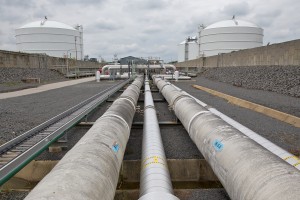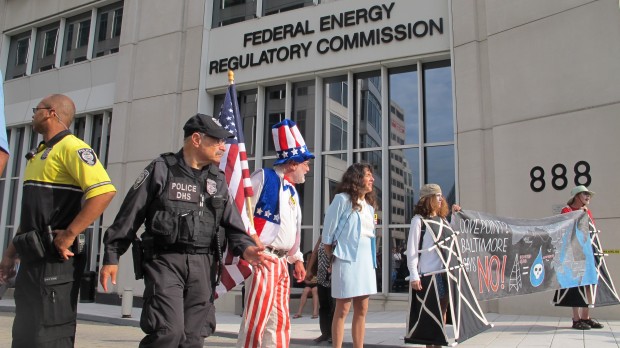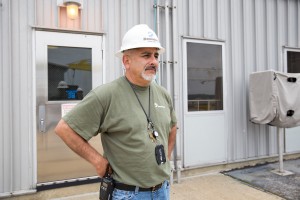Gas industry urges U.S. to speed approval of LNG export terminals

Lindsay Lazarski / WHYY
Liquefied natural gas pipes circulate around the Cove Point, MD terminal into holding tanks. The former import terminal is now under construction to become an export facility.
The natural gas industry’s leading trade group on Thursday stepped up pressure on the federal government to approve plans for liquefied natural gas export terminals, issuing a white paper which argues that the U.S. risks missing an opportunity to dominate the global market unless it acts quickly.
America’s Natural Gas Alliance said the U.S. could reap economic, environmental and geopolitical benefits if it builds terminals to give abundant domestic supplies of the fuel full access to world markets.
There is also strong overseas demand for natural gas, as shown by Shell’s recent agreement to buy the integrated natural gas company BG Group for $70 billion, ANGA said.
“The United States can become a global energy leader by exporting a share of our abundant natural gas supplies without sacrificing the competitive advantage enjoyed by domestic manufacturers,” the report said. “But we need to act soon.”
ANGA urged the federal government to speed its approval of applications for LNG export terminals such as Cove Point in Maryland — the closest to gas coming out of the Marcellus Shale — which is awaiting final approval by the U.S. Department of Energy.
ANGA chief executive Marty Durbin told reporters on a conference call that there are about 30 applications pending for the terminals, which can cost $10 billion or more to build. There’s no chance that all 30 will be built, he said, but those that have the right capital and market openings deserve the chance to succeed. He declined to predict how many terminals will eventually be built.
According to the white paper, “Carpe Diem: LNG Exports a Once-in-a-generation Opportunity for America,” four terminals have received final approval from both the DOE and the Federal Energy Regulatory Commission, and two more – at Cove Point and Corpus Christie, Texas – are awaiting DOE approval after being approved by FERC in 2014.
Durbin called on the DOE to issue a “blanket approval” for LNG export terminals, and declare that they would be in the national interest. He welcomed last year’s DOE decision to scrap its “conditional approval” stage but urged it to speed the process further by allowing applications to be passed to FERC more quickly.
He rejected what he called “inaccurate and in some cases disingenuous arguments” by some sections of industry which say that stimulating demand for natural gas overseas would drive up domestic prices and erode a competitive advantage that has been enjoyed by U.S. manufacturers since the U.S. shale-gas boom began in the mid-2000s.
The Industrial Energy Consumers of America, a trade group that says it represents manufacturers with some $1 trillion in sales, in January urged the Obama administration to avoid any further export terminal approvals until the DOE defines whether gas exports are in the public interest.

Marie Cusick / StateImpact Pennsylvania
Twenty-four protesters were arrested for blocking a public passageway outside the Washington D.C. headquarters of the Federal Energy Regulatory Commission in July, 2014.
IECA President Paul Cicio predicted that gas exports will drive up domestic prices in the same way that they have in Australia – one of the countries that ANGA says is poised to take market share from the U.S.
“The gas industry is promoting the same reckless anti-consumer policy that they did in Australia,” Cicio told StateImpact in a statement. “Now, Australian consumers are being forced to buy the equivalent of higher LNG export prices and manufacturers are shutting their doors and power plants are taking action to convert back to coal.”
Meanwhile, environmentalists argue that increased sales of natural gas will spur higher production by an industry that they accuse of contaminating air and water with the by-products of the fracking process, and accelerating climate change.
“LNG exports are a terrible idea,” said Iris Marie Bloom, director of the anti-fracking group Protecting Our Waters. “They would escalate climate change, due to the large greenhouse impacts from cradle to grave shale extraction.”
Durbin told reporters that new reports of vast U.S. reserves underline the need for quick approval of terminal applications. The evidence includes a biennial report from the Potential Gas Committee, part of the Colorado School of Mines, which said on April 8 that the U.S. has 2,853.2 trillion cubic feet (tcf) of gas that is recoverable with existing technology, or about 100 times the quantity that was consumed nationally in 2014.

Lindsay Lazarski / WHYY
Liquefied natural gas technician Ernest Ortiz moniters the process from the offshore control center at Dominion's Cove Point plant along the Chesapeake Bay.
The latest PGC estimate, 6 percent higher than in 2012, included Appalachian shales, primarily the Marcellus but also the Utica and Kentucky’s newly assessed Rogersville Shale where reserves collectively rose by to 137 tcf, or 24 percent higher than in 2012.
Although the plentiful supplies have driven natural gas futures prices to near three-year lows, Durbin argued that’s unlikely to deter demand for the export terminals because they will be based on long-term contracts over 20 or 30 years.
“It isn’t like we’ve seen a lot of companies dropping out of the queue for FERC and DOE,” he said.
Despite this optimism, in early April, Moody’s Investors Services forecast that low oil and natural gas prices will force the cancellation of most planned gas export terminals in the U.S. and Canada.
Projects now under construction, such as Cove Point, will likely succeed but most others now proposed will be rendered uneconomic because of the low-price environment, Moody’s said.
















